traversing overland from Arch Cape to my house via Onion Peak

For seven years now I've gazed upon the sentinal of Onion Peak. It's bulwark has supervised the creation of my boatbuilding business, and then my organic farm. At times bathed in the warm glow of sunrise or sunset, at others wrapped in fog, blasted by rain, and covered with ice, I glanced up again and again at the crags, simply wondering what was up there. Carefully studying the fissures upon it's central column, I entertained idle fantasies that just maybe some of the rotten choss-rock had peeled off the face exposing a band of cracked columnar basalt that would accept some of my long-neglected collection of nuts and cams for an epic decent straight down the middle.
Who has time for such things though. Who has time for anything really? It never ceases to amaze me how fast one year dissapears into the next, and how I always find time to do the things I have to do, and so often the things I want to do are set aside to be done in some mysterious future that is always around the corner but never seems to arrive. This winter I've been attacking that list with fervor, and so it was that I found myself connected to my buddy Don's voicemail at 8pm:
"hey Bro, it's me Brian, the weather is good and I think we should climb Onion Peak tomorrow, camp on top, rappel down the face, and then bushwhack straight to my house." beeeeeep.
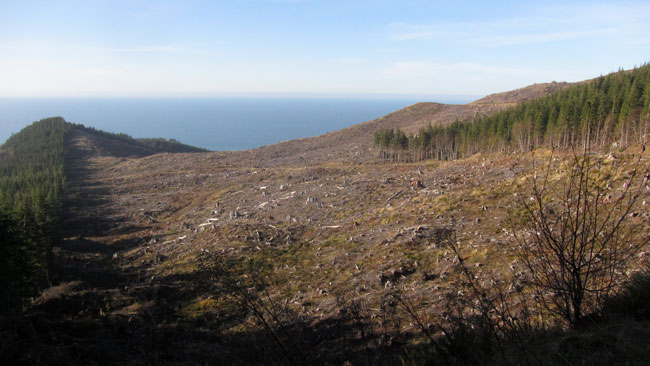
Another way to phrase that might be: "Would you be interested in carrying fifty pounds of climbing gear seven miles and three-thousand vertical feet up a maze of logging roads through endless clearcuts, thrashing through wet slippery thorny brush up to a crumbling mountaintop where we'll freeze our nuts off and won't sleep a wink on uneven windswept rock, then wake up and make a highly inadvisable vertical decent down a cliff that we have no reasonable expectation of finding any sort of safe anchors, wherepon (provided we survive) we will continue to thrash straight cross country through more of the aforementioned brush finally arriving back at my farm."
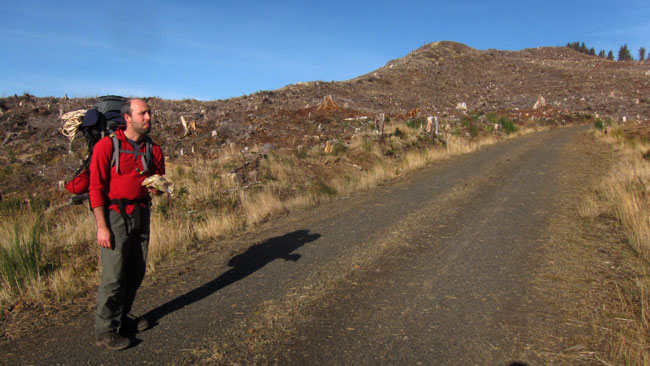
I can always count on Don for any adventure that involves extended unpleasantness combined with the probability of getting lost and the possibility of getting killed.
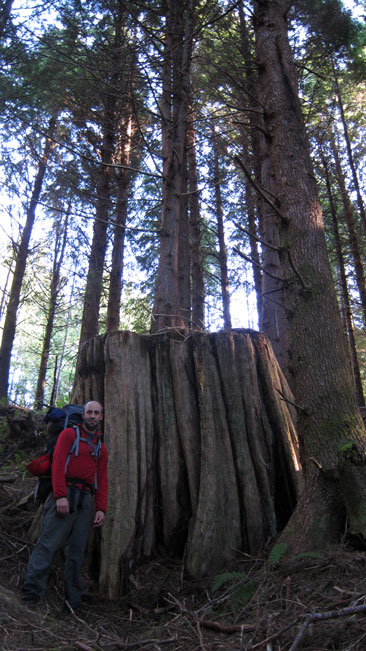
Rather than take the normal arduous route up steep logging roads, Don felt it would be a good idea to make an instinctual cross-country shortcut. This turned out to be something like climbing a muddy stairmaster for two hours with backpack while being whipped raw by branches and brambles. Not surprisingly, this turned out to be neither shorter, nor easier, especially because aside from the occasional long whitewater portage, I do little to no hiking.
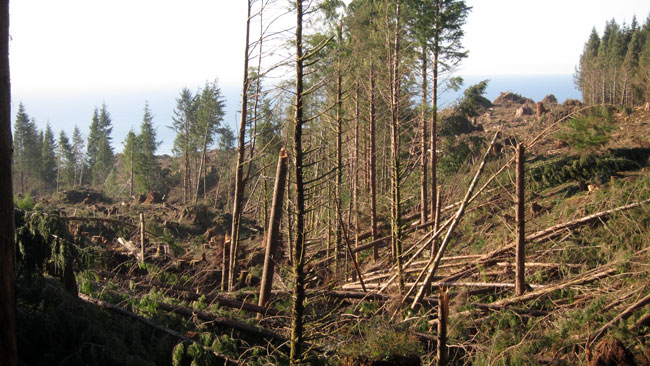
Back on the roads we were treated to a six mile tour of greed and devastation. What you are looking at here is 'a stream buffer to protect habitat'. This land could have been selectively harvested encouraging a diverse healthy forest, instead large private landholders simply clearcut and move on. Currently there is less than one-half of one percent old-growth forest on the Oregon coast, but a burgeoning market for pulp is now making it barely profitable to cut down the young second growth to be shipped overseas and ground up for pulp. It's disgusting. Timber interests always like to whine about regulations when the reality is the reason there are no timber jobs is because they've already cut down most of the trees.
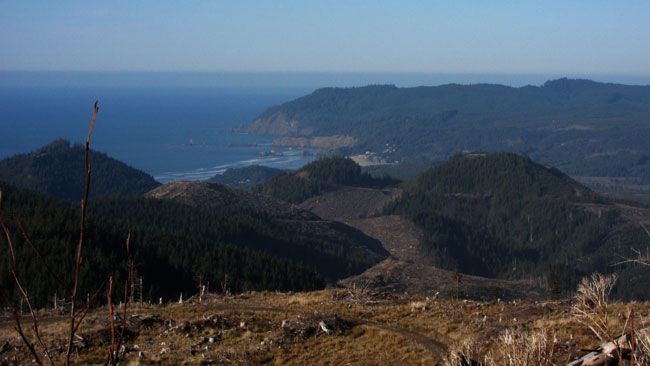
Farther us we got some nice views of Ecola state park and Cannon Beach.
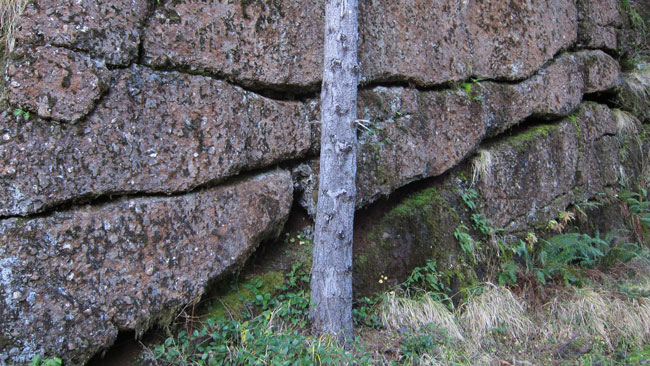
A cool rock and tree.
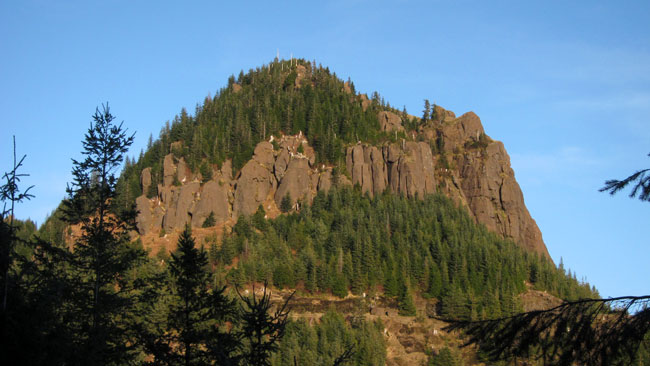
We slogged a brutal pace to reach the base of Onion Peak an hour before sunset. The Nature Conservancy purchased this land a few years ago.
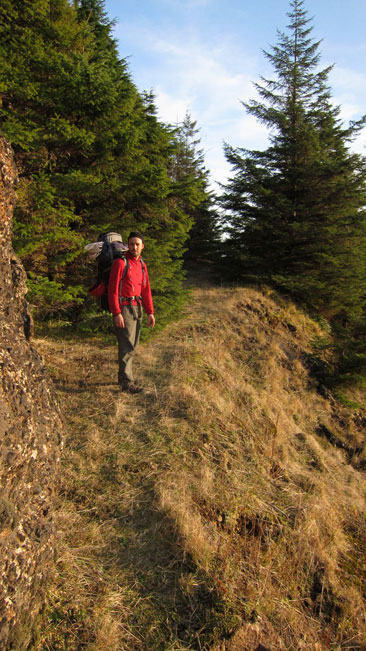
The end of the road.
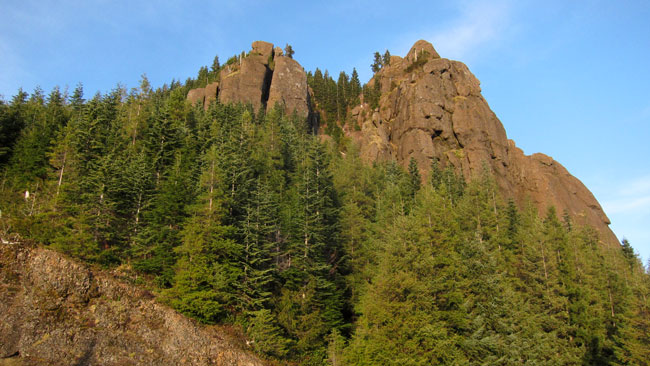
Seeing my chance to repay Don for the evil thrashfest he imposed on me earlier in the day, I suggested we forgo the normal trail and take a more "direct" route to the top via this gully.
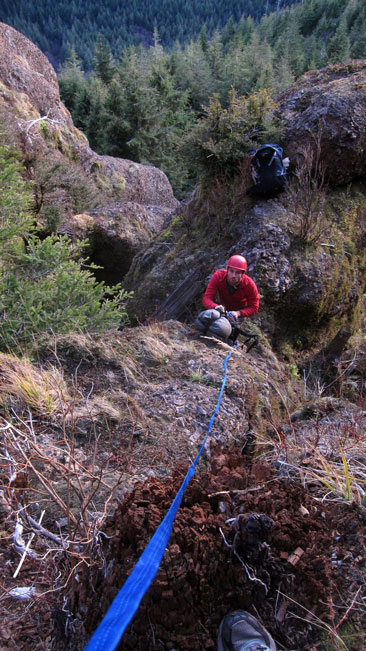
he, he, he..... Just as I'd hoped.
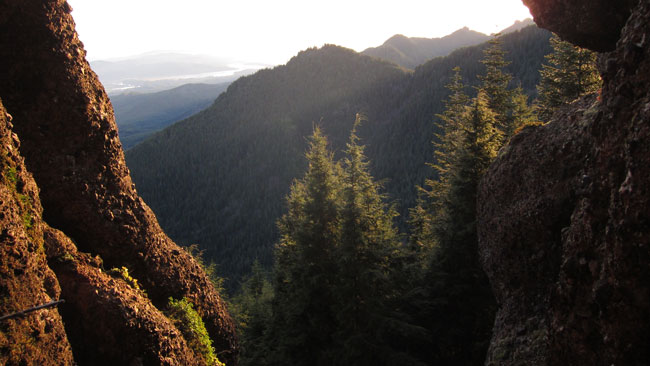
Halfway up, less than a half hour of daylight left.
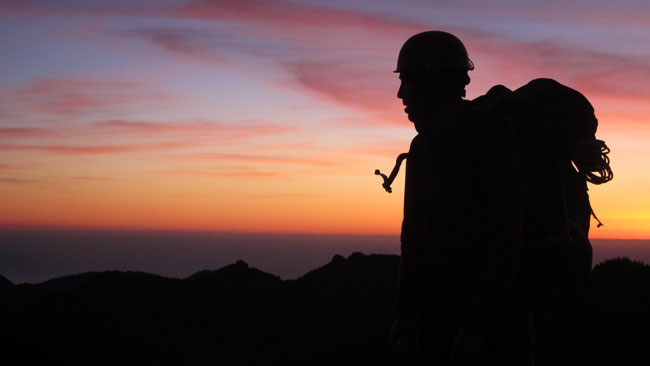
A quadracep destroying half-hour later we quavered victoriously on the peak as the sun melted into the Pacific.
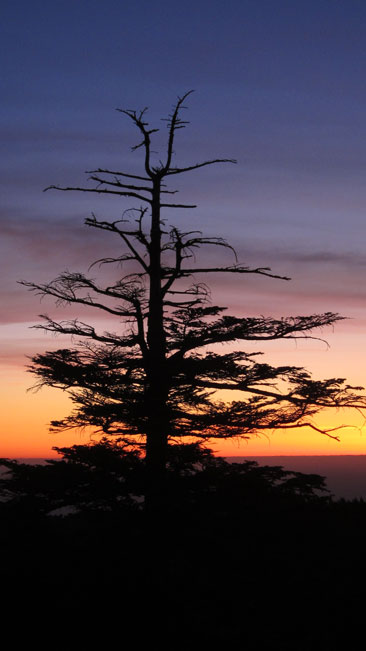
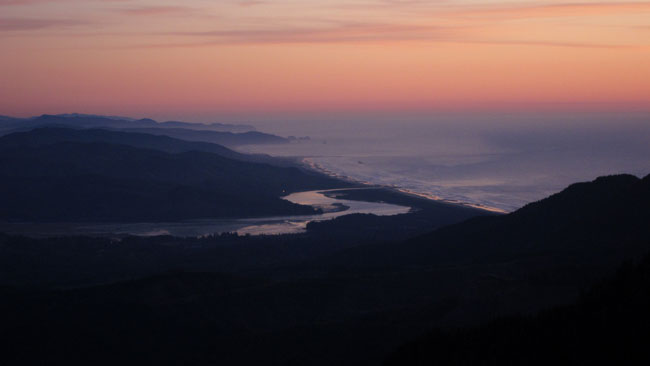
Nehalem bay.
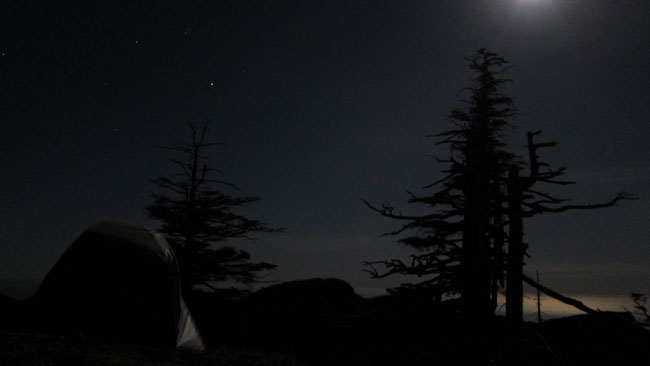
As romantic as it looks, you need to be both stupid and a scofflaw to camp up here. There is nothing resembling a flat spot, the wind howls, and each side of the tent opened to a potentially fatal fall. The Nature Conservancy does not allow camping here to protect the habitat, but more to the point, it's just a bad idea. I plead forgiveness based on the fact that I've wanted to do this long before they bought the land. To reiterate, camping here is illegal and dangerous. It is murder getting a pack up here anyways. There are nice spots with exactly the same views at the base of the peak on the old logging road.
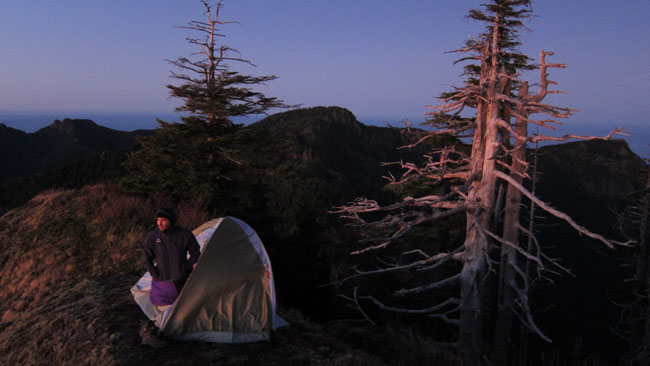
First light.
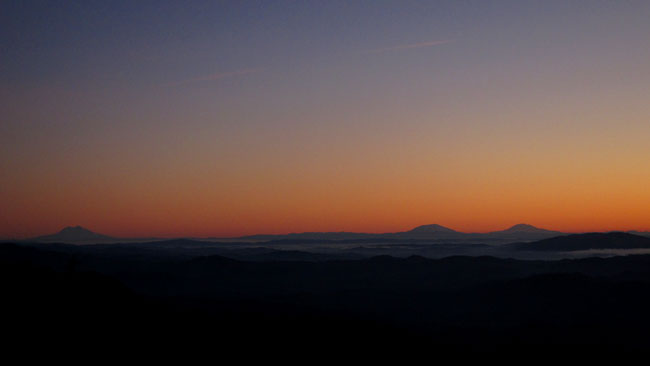
Rainier, Helens, and Adams at sunrise.
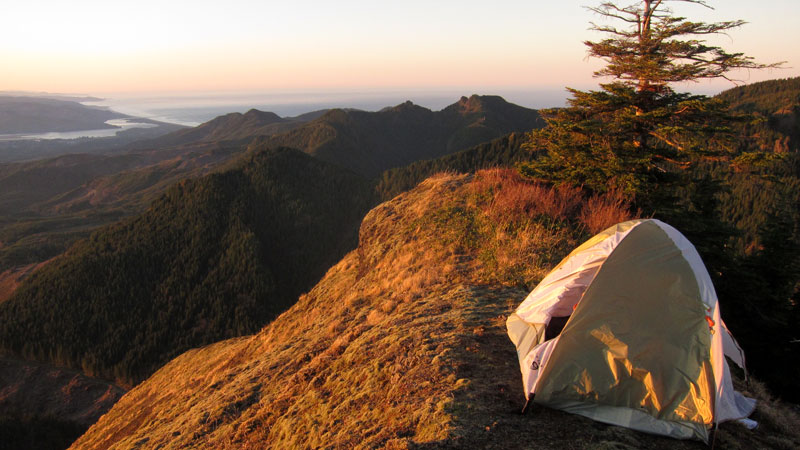
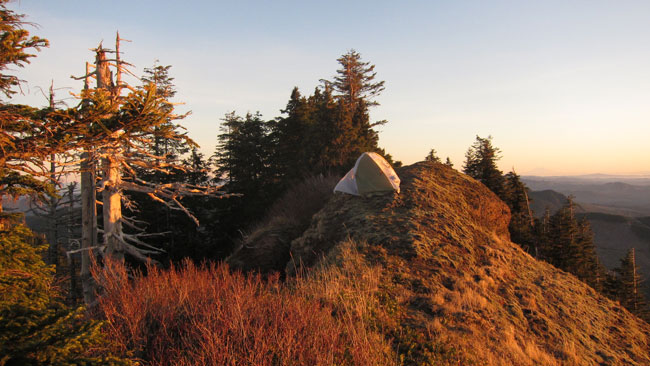
Nearly crippled from (not) sleeping on baseball sized chunks of sloped rock, we rose to greet the rare winter sun. From this amazing vantage we watched a Peregrine Falcon swoop and dive in front of us. It was the first time I'd seen one fly for more than a moment and from this distance with a clear view I was struck by how unique it's flight was. Compared to other birds I'd watched fly at altitude, the fast arcs that it carved were cleaner, more steady.
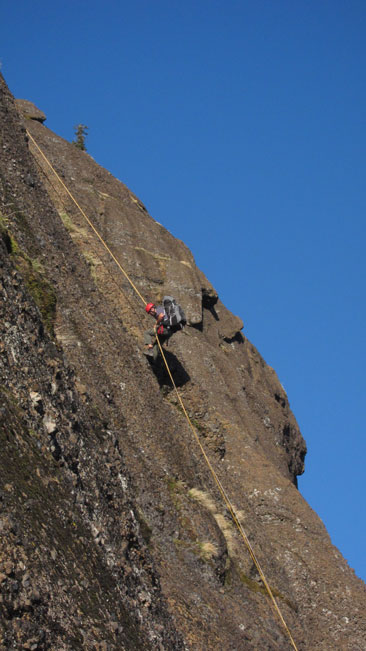
Though it was clear that there was none of the solid rock I'd hoped for, we strung out the climbing gear anyways and started carefully working our way down the face. This seven-hundred foot drop required careful strategy to insure that we didn't rappel into a situation we couldn't escape from. We strung out a pair of two-hundred foot ropes, and I dropped down, worked out an anchor, and then rappelled on a single 120 foot rope down to establish a second anchor, then Don would come down, pull the ropes and drop them down to the second anchor. At this point we were committed, but if we were unable to find a third anchor point, we could still tie all the ropes end to end and rappel to the base.
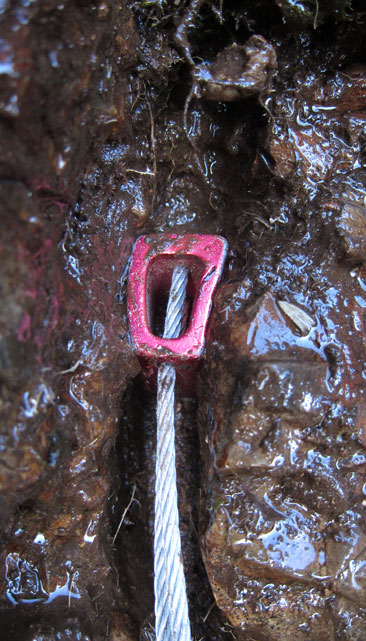
For anyone keen on repeating this feat, allow me to call your attention to what I mean when I say 'anchor'. Our first two anchors were trees, our third was a slung rock, but our fourth, completely committed, and most exposed anchor consisted of three small nuts slotted into a wet muddy crack.
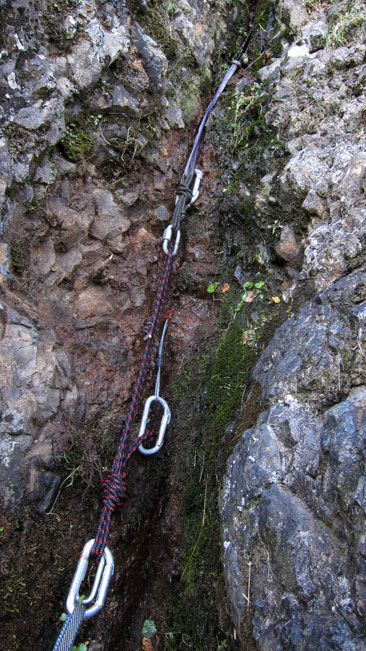
As horrifying as this looks (even to me), I established this anchor by digging moss out of the crack with my fingers and a pocket knife, then slotting a nut, and still safe on rappel, I'd transfer my body weight onto the piece and jump up and down on it like crazy. I did the same with each nut and then using slings, prussiks, and a cordlette I managed to equalize the trio, making sure to check it for stability in any possible direction of pull. My bottom nut was securely wedged behind a nub that prevented the top two from lifting out. I could have slotted another piece, but this felt solid and I trusted it. I haven't built many trad anchors since I quit seriously climbing fourteen years ago, but the intense focus of ever having done so made it seem as though it was yesterday.
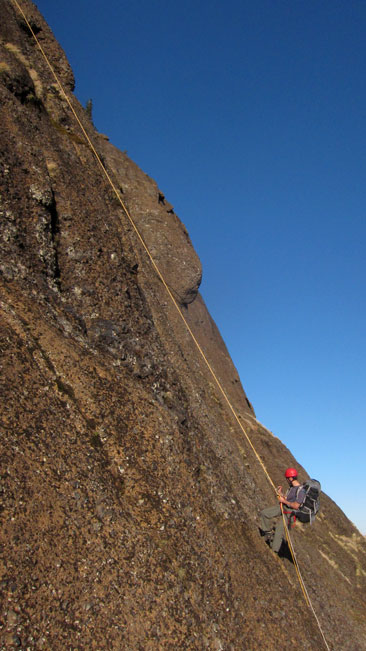
We were incredibly lucky on finding anchors, I was at the literal absolute end of my rope on each section when I found or made an anchor. On the final rappel the rope ran out just as our feet touched the ground. We brought a total of 520 feet of rope and to do it over with I should have brought an extra 120 feet and a couple of pitons and a hammer. It was fun to do, but it's just not a climbing friendly place. The rock falls apart in your hands.
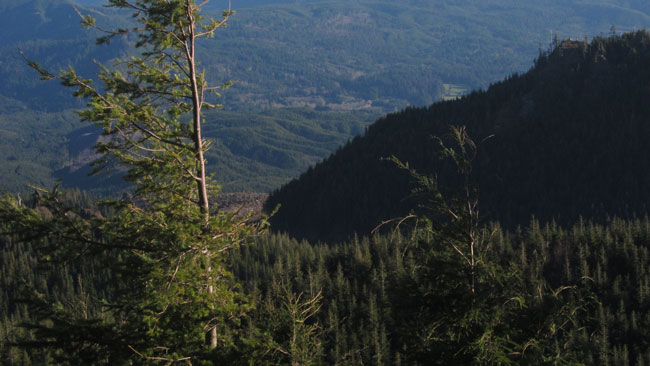
After eating lunch and coiling the ropes, we were ready for the really fun part, a straight line bushwhack to my house four miles distant. At least it was downhill.
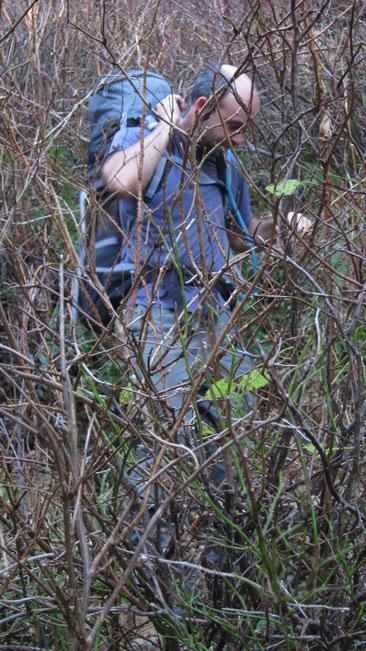
alas, this is the last picture my camera ever took. In the midst of our downhill bramble-thrash we encountered a small cliff band where I was heard to utter the phrase,
"Don't worry, it's all good."
....followed by a slide, tumble, and crash! I stood up bleeding a bit, and winced at my smashed Canon s95. Not a bad price to pay considering what could have happened. I yelled back up to Don,
"Ok, maybe it's not all good!"
Below the peak we traversed a landscape of fantastic volcanic spires and outcrops amidst massive clearcuts. This area should have been preserved as a park and it was sad to see it cut. Our cross country epic continued well into the darkness, and we arrived on my doorstep scratched and bruised. I lit a fire in the wood-fired hot tub and cracked open a well earned Jubelale. Not a bad adventure considering it was hatched in day and a half and executed with very little gas or money. Sure our rainforest is clearcut to all hell, but it still has it's charms. (thanks and apologies to the Nature Conservancy)
Back to Cape Falcon Kayak